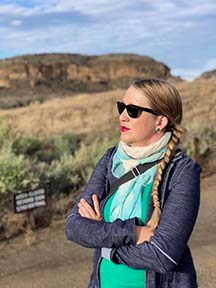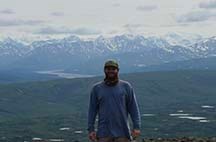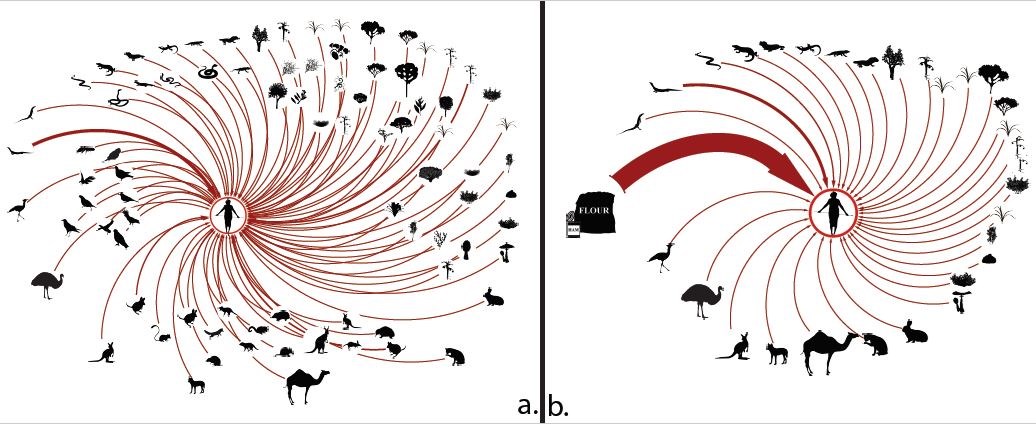
Studying the Human Place in Food Webs
Stefani A. Crabtree, Ph.D.
Assistant Professor in Social-Environmental Modeling, Department of Environment and Society, College of Natural Resources, Utah State University, United States
ASU-SFI Center for Biosocial Complex Systems Fellow, The Santa Fe Institute
Fellow, Le Centre de Recherche Interdisciplinaire
Associate Investigator, Australian Research Council Centre of Excellence for Australian Biodiversity and Heritage
Research Associate, Crow Canyon Research Institute

Evan Holt, Ph.D. student, Utah State University, United States
July 16, 2020
Humans have been integral parts of global environments for at least the past 125,000 years, yet often modern ecological studies remove humans from ecosystems. This act denies the rich history of the ways that humans and ecosystems have co-evolved over generations. Further, studying ecosystems in this way removes the ability to understand the ways that humans have incorporated Traditional Ecological Knowledge (TEK) into the ways they interact with and within ecosystems.
Recently, though, several studies have begun incorporating humans directly into ecological networks to examine these deep-time interactions. By combining studies of ecological interactions with TEK from Indigenous communities, we have begun to better understand the human place in ecological networks worldwide. An understanding of humanity’s place in ecosystems is critical for advancing modern sustainability practices.
A natural way to place humans in ecosystem studies is through the study of food webs. A food web is a network of consumption relationships. For example, when a rabbit eats a plant and then is eaten by a coyote, that forms a food chain. Yet, the coyote may have eaten a vole yesterday and tomorrow will consume a prairie dog. Once all these food chains are connected, what is called the “full trophic network” or “food web,” can be created. These networks are useful for studying the fragility of a system to environmental change--if a drought happens and grass doesn’t grow, what would happen to the herbivores and carnivores?
Recently, research in Yellowstone National Park has suggested that the reintroduction of wolves to the ecosystem has helped stabilize the food web.1 Their presence as an apex carnivore has helped keep ungulate populations, like elk, in check, thereby restoring riparian zones. These downstream ripple effects are the reason food webs and other ecological network approaches are so powerful. They can help illuminate how certain, small actions have cascading consequences on the system as a whole.
If research shows that wolves can help stabilize ecosystems via their consumptive effects, this potentially has implications for understanding the human place in ecosystems as well. Traditional societies often embed themselves in ecosystems, providing many important effects for the stability of the overall ecosystem.
Such is the case for Martu Aboriginal people in the Western Desert of Australia. In 1964, the government removed Martu from their traditional lands. When Martu were allowed to “return to country” in the late 1980s, they returned to a landscape that had been dramatically altered. Without people stewarding the land, fire regimes had shifted, and several small-bodied mammals had gone extinct. Paradoxically, people seemed to have been keeping the ecosystem together.
When my team sought to model the food web of the Western Desert, we began by interviewing Martu about the animals within the region.2 While there have been several scientific studies of animals there, the deep knowledge of the traditional landowners complements and often surpasses the published literature. By asking them about what they ate, when they ate it, and how the taxon was acquired, and the habits of several of the endemic species (including the ones that are now extinct, but who older Martu remembered vividly), we were able to construct a highly-resolved food web for the Western Desert.

By: Crabtree and Team
By simulating the effects of extinctions on the food web built from 1964 and examining the place of humans in the network, we were able to show that their removal had disproportionate effects on the stability of the network. One finding is that Martu exert extreme predation pressure on large-bodied herpetofauna, which in the summer months have few other predators. By removing Martu, these lizards and snakes were less vulnerable to predation and could exert their own predation pressure on the smaller mammals.
Additionally, the use of fire for hunting by people disappeared when Martu were relocated. Human-lit small fires lead to a patchy mosaic of regrowth on the landscape, which is resistant to large wildland fires. Without this patchy mosaic brought about by traditional practices, lightning fires in the summer could burn unfettered. The combination of losing humans as ecosystem engineers and as extreme omnivores destabilized the Western Desert food web, leading to cascading extinctions.3
Another humans-in-food-webs study examined the Aleut in the Sanak Archipelago of Alaska and found that they, too, were extreme omnivores within their system and, like the Martu, exerted important predation pressures. The Aleut’s predation of seals, especially the need for three or more skins for kayaks on a yearly basis, dampened the seal populations enough to support the local fisheries; researchers suggest that the removal of Aleut led to an increase in seal populations and a decrease in cod. Yet Aleut, with their hunting technology (kayaks, harpoons, etc.) that allowed them to hunt large animals, had the ability to over-exploit the marine and nearshore ecosystems, yet they seemingly never did. By building food webs and simulating the idea that a predator with technological advances could overexploit an ecosystem, Dunne and colleagues were able to show that the choices of Aleut to exhibit extreme omnivory and to “prey switch” (hunt a different animal once marginal returns on initially targeted taxon decrease below an arbitrary threshold) helped stabilize the ecosystem.4
So, we can see how Traditional Ecological Knowledge gets embedded in the choices that people make when they consume, and how TEK can provide stability of an ecosystem. Among Martu, the use of fire for hunting and the knowledge of the habits of animals are enshrined in the Dreamtime stories passed inter-generationally; these Dreamtime stories have material effects on the food web, which were detected in our simulations. The ecosystem thrived with Martu; it was only through their removal that extinctions began to cascade through the system.
A final food webs study examines when sustainability can be achieved in certain aspects of life while not in others.5 This study recreated food webs for the Ancestral Pueblo People of the American Southwest, many of whom lived in what is now Mesa Verde National Park. According to archaeologists, the Ancestral Pueblo People migrated into the region around AD 600, bringing with them a suite of domesticated plants, such as maize (corn), beans, and squash, and they moved from the region by AD 1300.
The question of why they left has been studied by archaeologists for about 125 years. Applying a food web lens, my team examined how the food webs and the surrounding ecology changed over the course of 700 years of farming. We found that the ability to prey switch, as in the above Aleut and Martu cases, was curtailed by increasing density of population, leading to a landscape where wild resources became farther and farther away.
This change decreased the quality of life of Ancestral Pueblo, even as their experiments with farming led to sustainable practices. The resilience of Pueblo culture can be seen in how they were able to migrate to new landscapes, bringing with them the ecological knowledge they had learned while farming in the central Mesa Verde homeland for 700 years.6
Yet, the effects of humans on landscapes can be mixed. Alongside sustainable practices enshrined in TEK can be unsustainable practices, as illustrated above, which require remedial action. For the case of the Ancestral Pueblo, the remedial action was leaving Mesa Verde to bring their long-learned farming practices to new homelands. The archaeological record and communications with Indigenous peoples can provide a way to look at past ‘experiments’ with sustainability, helping us to identify the ways that humans have positive impacts on ecosystems, when they do not, and how these interactions get ossified into TEK. This, then, can provide a lesson for modern sustainability. By understanding the difficult choices people in the past made, we can learn how to have sustainable interactions with our ecosystems today.
The combination of archaeological data, often from midden deposits that give large quantities of rich taxonomic information, and Traditional Ecological Knowledge from descendent communities lend generational knowledge of local environments and ecological practices that create a richer understanding of ecosystems.
The role humans play in shaping ecosystems is not new; while today it is difficult to conceptualize an environment that is not entangled with humans, this entanglement has deep roots. Combining historical, archaeological, and ecological data with Traditional Ecological Knowledge shows the deep-seated place that humans hold in ecosystems worldwide. We are a part of the global food web; studying how people have learned to build sustainable practice in the longue durée may help us to have a sustainable future.
[1] https://www.yellowstonepark.com/things-to-do/wolf-reintroduction-changes-ecosystem
[2] https://link.springer.com/article/10.1007/s10745-019-0053-z
[3] https://www.nytimes.com/2019/02/08/science/australia-aboriginal-fires-martu.html
[4] https://www.nature.com/articles/srep21179
[5] https://www.eurekalert.org/pub_releases/2017-04/ps-fwe040617.php
[6] https://www.sciencedirect.com/science/article/pii/S0305440317300377
Last updated: July 10, 2023
